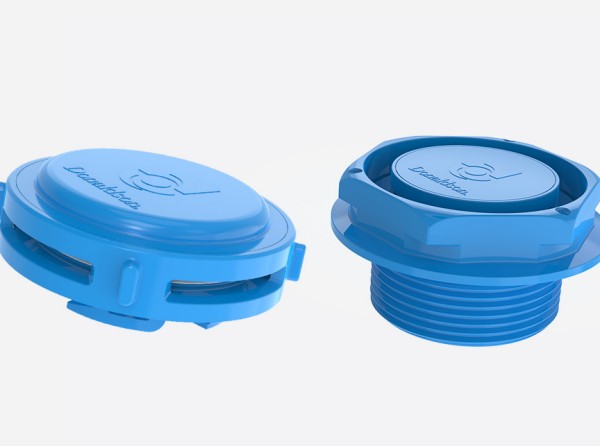By Shane Campbell, Product Manager, Donaldson
Today’s evolving design trends and automotive industry standards are influencing the appearance, durability, and performance of new electric vehicle models – even down to the design of their battery pack vents. As consumer demand for Electric Vehicles (EVs) continues to grow, so does the demand for innovative batteries that provide more power and longer range.
As batteries become more sophisticated, the need to protect them from the elements has never been greater. Battery pack engineers understand vehicle applications and by marrying them with proper venting technology, they are helping advance EV performance.
Below are five important considerations that Donaldson incorporates when designing a solution to help maximize vehicle battery pack performance:
1. Provide Pressure Equalization

Temperature and elevation changes can cause pressure variations inside a pack enclosure. Vents allow air to flow in and out of the enclosure, which helps equalize the pressure. Higher airflow allows faster equalization and lower maximum pressure differentials. As pressure builds in an operating system, the weakest point will be found, so a properly designed vent takes the pressure off sensitive components within a vehicle and helps maintain proper airflow.
The rate of pressure change also needs to be considered. Pressure changes are often driven by temperature changes inside the battery pack due to environmental conditions, charging, and discharging. As the rate of pressure change increases, higher airflow is required.
To handle fluctuating pressure changes, the size and number of vents, type of membrane, airflow properties, and outside conditions need to be considered at the onset of development. Implementing the appropriate type and number of battery pack vents can help manage the internal pack pressure at differential operating conditions.
2. Engineer for Ingress Protection
While airflow requirements are critical to managing pressure levels in battery packs, ingress protection to keep out contaminants is also an important consideration. A key parameter to use during the design and testing phases is the ingress protection (IP) rating, which indicates the effectiveness of sealing enclosures against foreign bodies and moisture.
Typical contaminants a battery vent must protect against include water (spray and submersion), oil, dust, and sand particles. Donaldson’s dual-stage battery vents utilize a unique body design and Tetratex™ ePTFE membrane – a proprietary filtration media – to provide exceptional battery pack protection.
As ingress protection is increased, emergency degassing airflow may be decreased, so proper venting solutions need to find the optimal balance between ingress protection and degassing airflow.


3. Account for Edge Cases
EV battery packs and enclosures are created to handle unexpected edge cases, which are events that occur at extreme operating parameters. While edge cases occur infrequently, it’s important that a venting solution is optimized to help reduce the risk of damage to the battery pack and mitigate component failure or costly repair.
Below are a few edge-case scenarios that Donaldson tests their products up against:
- DC Fast Charging – This charging process is significantly faster than regular charging stations and generates extra heat and pressure on an EV battery.
- Hill Climbs – The competitive sport of uphill racing causes a sudden change in altitude and increases the pressure and temperature in a vehicle battery.
- Water Fording – Driving off-road through a creek can put a warm battery pack in thermal shock and cause a rapid vacuum event from the cool water.
- Air Transportation – A vehicle being transported by an aircraft will be impacted by pressure changes from the altitude variation.
- Rock Impact – Rocks or other hard debris hitting the undercarriage of a vehicle can cause a pressure spike inside the battery pack.
Donaldson’s testing process includes a comprehensive design failure mode and effect analysis. This analysis looks at the severity and frequency of possible edge cases and tracks them in a validation plan.
Additionally, Donaldson works with customers to understand what extreme conditions their vehicles may experience and what requirements are needed to retain driving performance during a sudden edge case scenario.
4. Mitigate Emergency Degassing Events
As with edge cases, Donaldson designs its battery pack vents to help manage battery pack pressure during emergency degassing events, such as a thermal runaway, which happen when pressure rises to a concerning level and gas needs to be immediately released from the pack.
Donaldson’s dual-stage venting solutions are designed to help manage these escalated situations. In an event one occurs, the second stage fully opens to allow rapidly expanding gases to escape in a controlled manner. This mechanism helps prevent further damage to battery cells or a pack enclosure.
5. Perform a Full Temperature Range Validation
Donaldson designs its battery pack vents to operate in a variety of operating temperatures. Donaldson’s engineering team frequently performs tests in a full range of extreme temperatures to see how their vents handle burst pressure, emergency degassing, pressure cycle, thermal cycle, thermal soak, thermal shock, and vibration.
Dual-Stage Venting Solutions

Dual-stage venting helps optimize EV battery design. Stage one equalizes pressure while preventing the ingress of water and contaminants. Stage two venting fully opens in response to rapid pressure and heat buildup to allow expanding gases to escape and reduce further damage to remaining cells. In most situations, a single vent assembly can accomplish both functions.
Donaldson’s dual-stage venting solutions provide sealing and guarding, pressure equalization, effective ventilation, and mitigation of gases in the case of a thermal runaway event.
Donaldson has supplied more than a billion vents that help provide protection from pressure fluctuation, liquids, and harmful contaminants. From automotive battery pack vents to outdoor lighting and hearing aids, Donaldson’s differentiated solutions are helping meet critical component needs and supporting industrial manufacturing processes in a variety of industries, including the rapidly growing EV and hybrid vehicle market.
You May Like...




